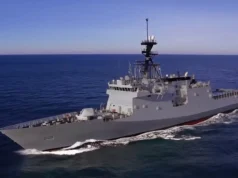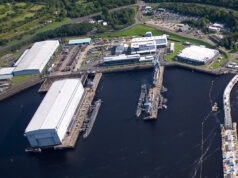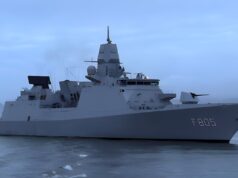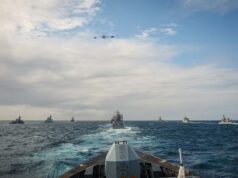In a recent response to a parliamentary question, Lord Coaker, Minister of State at the Ministry of Defence, confirmed that nine Type 23 frigates are currently in service with the Royal Navy, with six of these vessels presently available for operational deployment.
This update came in response to a query from Lord West of Spithead, who inquired about the number of frigates in the Royal Navy’s active order of battle.
Lord Coaker stated “As a new government, we inherited a situation in which the Royal Navy has nine Type-23 frigates in service, six of which are currently available”, he then went on to explain, “The normal operating cycle of every ship involves them entering different readiness levels depending on their programmes and departmental planning requirements.”
This cycle can affect the availability of vessels as ships undergo scheduled maintenance, refits, and other planned readiness adjustments.
As part of its long-term strategy, the MOD is advancing a gradual transition from the existing Type 23 frigate class to two new classes, the Type 26 and Type 31 frigates. This shift will unfold over the next decade, with these new ships intended to enhance the Royal Navy’s capabilities in both anti-submarine and general-purpose roles.
In context
Recent trends in the fleet, particularly the Type 23 Frigates, show a positive shift towards increased operational availability.
Earlier in the year, we reported that a lower percentage of these ships were active or immediately deployable, with the majority undergoing maintenance or refit. However, recent data indicates a marked improvement, with more ships transitioning from maintenance to active status.
This improvement is particularly notable in the Type 23 Frigates, where the percentage of active ships has risen significantly, reflecting better fleet management and possibly more efficient maintenance practices. The removal of HMS Argyll from service has also played a role in this trend. While this reduced the overall number of Type 23 Frigates from 10 to 9, it has not hindered the increase in the percentage of active or deployable ships.
On the contrary, the focus has seemingly shifted to maintaining the readiness of the remaining vessels, leading to a higher proportion of the fleet being operational. The Royal Navy has managed to enhance the availability of the fleet despite the reduction in total numbers. This trend suggests a strategic shift in the Royal Navy’s approach to fleet readiness and operational capacity. By improving the availability of its remaining vessels, the Royal Navy has increased its ability to respond to operational demands.
The data, in summary, indicates a focus on maximising the utility of the existing fleet, ensuring that a more significant percentage of ships are prepared for immediate deployment when needed.














For comparison 16 Frigates and 8 destroyers were sent South Atlantic to take the Falklands back.
Maybe however as an example a type 45 is probably 15-30 times more effective than a Type 42. So I’m not sure what your numbers prove.
In what way is it 15 to 30 times more effective?
One or two Type 45s could have decimated the entire 35 fighters of the Argentine air force during the 1982 Falklands….
Area defended, probably
Aster 30 Vs Sea Dart is a massive range increase.
Multiply that by number of missiles carried and you probably don’t get far off 30
It’s can shoot sea skimming missiles for a massive start, T42 relied on its hull or helicopter facilities to catch Exocet.
ask Prince Exocet Andy he knows all about at them.
T42 was nearly useless whilst T45 has, as SailorBoy said, the ability to defend itself and ships in a task force effectively over a wide area.
you should have been on my ship h.m.s Antrim with the sea slug that missed a Hercules off south Georgia because it only just made it off the launcher 😭
political spin
Numbers are still incredibly important. A single sub could decimate our entire destroyer fleet.
It can only be in one place at a time though
It only needs to be in one place defending a task force.
That comment just shows a complete lack of understanding of defence in depth and naval warfare in general.
True enough 👍
Absolutely correct. I wouldn’t argue with that.
Not in Argentina’ case but the greater capability of 45s over 42s is offset somewhat by the greater capability of ASMs and their launch platforms.
T42 in 1982 was completely unable to engage any sea skimming ASM on its time. T45 is capable of engaging any sea skimming ASM on the planet today as well as ballistic missiles.
God forbid the Argentines ever get their hands on anti ship ballistic missiles.
the argues would break them. and it would take half of the nations GDP to pay for it.
True but T45 can defend itself from ASMs.
the tears of surface ship v ship warfare are gone. I doubt they’ll ever come back.
As long as it doesn’t come up against a Chinese destroyer sporting 112 VLS whilst our ‘effective’ destroyers only field 48. In fact our top notch destroyers are pretty under-armed compared to most destroyer classes, think South Koreans, U.S.Japanes, etc. Although we could probably still beat the Argentinians.
So too have the ships in every other major navy increased their effectiveness. The reality is that the Royal Navy has nine frigates (eight if we assume that HMS Northumberland is done).
I’m not sure they have. The Russian Navy is nothing close to it’s Soviet predessor. The US Navy has not exactly increased it’s effectiveness in the last 30 years. Everyone has taken a peace dividend however I think NATO is generally much larger and much more effective than anything Russia can throw at it.
Problem is Communist China.
Communist China added 10 missile cruisers to their fleet since 2020 . More than 1000 VLS cells.
For Russia the problem is their submarines.
china is building three ships to the wests one the west MUST UP THE manufacturing area Chinese technology makes them a far more formidable threat than the russians
Clearly the UK cannot allow itself to be distracted from the immediate threat. My understanding is that China will not be a threat to anyone within the next 5 years as things stand.
look what the Ukrainian forces have done to Russia’ best kit, NATO would mince them without breaking a sweat. even their high numbers won’t save them.
True. Probably fair to say that Russia doesn’t really have much modern kit though.
Well a T45 can only be in one place at one time can’t it?
And the threats are more deadly now that back then surely?
So I am sure you haven’t the faintest idea.
Well T45 was built to counter the threats that T42 could only dream about. That was the point of them. Exocet was a severe threat in 1982 as we found out. The beginning of many advances to come.
Whilst it is true T45 can only be in one place at a time in a scenario like the Falklands that would not be a problem.
Except the Type 45 has virtually no ASW capability and would need ‘escorting itself’ from any sub surface threats. The Type 42 at least had sonar! We also had 28 SSN/SSKs in the fleet and 6 boats were deployed south. We would be lucky today if we could sustain 2 on Ops.
How would we sustain even a handful of ships 8000 miles away. We deployed over 20 RFAs to sustain the task force supported by multiple STUFT vessels.
The gaps in capability and the lack of numbers today is there for all to see.
hyperbole over 40 years. ago they won’t have to do it again
They certainly won’t be doing it again but those are the facts.
wee hope so
I thought a type 45 was around 6x the effectiveness of a type 42. That being the case our 6 type 45s means we could, in theory scrap maybe 2-3 together as a carrier strike group’s primary escorts. They are great defensive ships but lack offensive punch, requiring the carriers F35Bs to deliver that.
Yes well as we found with the Falklands the carriers needed to stay well out of range because the T42 was having difficulty defending itself let alone the surounding ships. With T45 shielding the ships it enables the carriers delivering F35B to approach. Obviously ASW would be needed but we have severals ways of delivering that.
Specious argument. Threats have also increased their lethality. Also one hull can only be deployed to one location. If you compare Type 45 with the latest Chinese ships they are woefully under armed and therefore we would need ten times the number. Circular argument!
Air defence is much better now, lessons were learned.
too late for the bomb that hit my ship in San Carlos water aka bomb alley
Yeah but most of them were shite. 2 T23, 2 T45 and 1 SSN with a QE class would be way better.
That would be pretty much the entirety of the available deployable RN force.
And today’s RN, despite being much smaller, would decimate the RN of 1982. And would bring unbeatable capabilities to Argentinian forces. People seem to think little has really changed since the 1980s, except we have got smaller. Technology training, support functions, and capability have come on leeps and bounds.
many lessons were learned from 1982 but the ability to deploy sufficient numbers has been left out of the agenda the quality of the fleet that was deployed was poorly equipped and designed. but the flexibility of the ships in the conflict was a massive advantage the ability to dominate the theatre in all areas was accomplished air, amphibian, and sea denial rendered the Argentine irrelevant once their Exocet number was used up they had nothing except one diesel submarine that could have been a concern the other Santa Fe was sunk by Antrim’s helicopter off south Georgia
And during the Battle of Cape Matapan during the Second World War, the Royal Navy had a carrier, 3 battleships, 7 cruisers, and 17 destroyers involved in a single battle, let alone the forces deployed in the wider Mediterranean.
Comparing forces deployed during events separated by ~40 years tells us fairly little other than how things have changed
Very well put.
Naval technology advances with time. If it didn’t, we would still be fighting naval battles with Cannon and Grapeshot!
the crusty old admirals at the MOD still think we do!
The difference in years between WW2 and the Falklands was 40+ years.
The difference in years between the Falklands and today is 40+ years.
Its a comparison that is no longer that valid regarding weapon systems and technology advancements.
As for ASMs…
Little has really changed. Sea Skimmers and High divers are still a thing now and that is something that the RN has known about, practised and exercised for since the 1960s.
People still use Harpoon, Exocet, AS4, TV guidance , ARM etc. Ballistics are a new thing but little different from a High diving (120k ft) M4.5 Kitchen or Kingfish from the 1960s.
In my view it is not just about numbers. It is a lethality as well. True we need a number of vessels as well otherwise you are putting all your eggs in one basket. That said ultimately drones etc. will spread the lethality and the speed of production providing the politicians however have the imagination.
politicians? imagination? in one sentence can’t be done!
True especially at the moment it seems 😀
More Ships needed so they can be deployed to more sea’s around the World. Modern tech should be being used to reduce crew numbers thus allowing more Ships to be manned and available. Presence is one of the biggest deterrence and for that you need numbers. If we had more bobbies on the beet then our streets would be safer but they are seldom seen these days. Same goes for the Military only with having if it can do its job of making the other side think twice and our Armed Forces are just too small to be really effective……sad to say but true.
Spot on 👍
Cant say manned…its crewed…😁😏
You can only go so far with reduced crewing. We found that out on T23 at its inception and then in later years. Double and triple hatting only goes so far hence the extra crew accom (converted storerooms and offices) for augmentees that has been put onto T23. In my case if FDO I couldn’t prep air weapons or be the secondary gun maintainer. If doing Boarding party and off ship I couldn’t do Ops Room Weapon System Engineer watches or action stations…
The underlying cause of USN collisions of late has been attributed to crew fatigue caused by reduced numbers and asking people to do more on watch time with less rest.
And thats before we even discuss fire fighting and plugging holes after a hit or damage which are massively crew intensive activities.
Never the less that is the way the Navies of the World are going. Just look at what’s coming up, bigger Ships with smaller crews driven by the cost of them and each sailor given many more hats to wear. In the 80’s and 90’s recruits had to wait to get into the Navy when the fleet had 70,000+ sailors but the youth of the current generation just don’t want to do anything hard. T42’s had large crews and even then all had several roles to cover. Much harder today. Something has to give…….But if you want security then it has to be paid for and that means more units available and deployed.
When I walked through the gates at Fisgard the RN was taking in, every 4 months, something like 300 baby tiffs into basic training. At the end of year 1 there where probably 200 left in. At the end of a 4-5 year apprenticeship that was probably halved again…and that split across ME, WE and WAFU trades.
Yes I double hatted on T42 and T22’s …I triple hatted ( at least!) on T23 and LPDs. It is not a workable solution. 18 hr days onboard. Little down time. Crisis managing a dept and systems. Notice going in and gaps which need covering meaning more hatting and that’s only regular steaming. Its a whole other level of crisis when on Operations.
Money wont fix it. Reduced manning and automation will exacerbated it.
I honestly dont know what the solution is. Double crewing T23 and MCMVs has helped out here but you need people to do it . Getting the people is the issue
that’s why many of us are on bere
there is a very big underlying problem with this and that is availability/readiness and maintenance cycles are a zero sum game, in that you increase one you decrease the others and each is important and decreasing any of them will have wide longterm consequences to either the quality of your fleet, the effectiveness of your deterrent or your ability to deploy in times of crisis or high risk ( war or pre war).
So you can raise one of these elements but you will impact on the others and impact on wider important issues.
That is why a recent U.S. senior officer wrote an interesting article around the only way to both maintain the quality of a navy or improve the quality of a navy is to maintain numbers and mass. This is because if you have low numbers and try to increase readiness /availability you have to decrease sea time, which impacts on the number of deployments and exercises, this reduces both your navies ability to practice and participate as well as an important part of any deterrent, which is visibility. If you increase sea time, you decrease the time you have for maintaince, crew shore side training, rest as well as readiness.
6 out of 9 , it was only a few years ago we had 13 . Not good
The Type 23s hulls were not built to last this long, compound that with glacial build progress on new types, it is not surprising.
The fleet is supposed to operate a two thirds forward, one third reserve structure. So six is the required number for the frigates here. Anything less should be classed as a planning failure.
It hasn’t done that for 20+ years.
Op capability drives available numbers
RN already on the path to resolution of this issue, by 2030, progress will be obvious. Simply need RN to avoid naval conflict during that period. 🤔🤞
It’s all good, we are just going to sail round the North Atlantic minding our own business until 2030.
Hopefully Xi waits for us 😀
A Labour government may have greater latitude from becoming embroiled in significant conflict, by emphasizing diplomacy and soft power measures, perhaps for a sufficient period to begin the process of British rearmament. View the current period to parallel the mid 1930s, exactly where on that timeline may be too difficult a task to discern. 🤔🤞🤞🇬🇧
“British rearmament”, in any serious sense of that term, would take a generation. It will be the 2040s before SSN AUKUS enters service for example. I would anticipate that the coming defence review will cap the fleet at 19 surface combatants (assuming some Type 26s are not actually sold off), limit the MRSS to perhaps three ships (of limited quality) and perhaps mothball one of the carriers.
… but of course an angry US administration, demanding that allies pay their fair share (which may or may not be elected today), could impact British and other allied defence planning.
Of course, am concerned that your assessment is substantially correct, but remain hopeful that the British electorate will recognize impending peril, before the tsunami engulfs them. It is just possible that the public would accept CWI level of defence expenditures to counter existential threats. There are also some potential shortcuts to rearmament (e.g., SLCM-N deployed on RN SSN-A), but agree progress will not be rapid.
Every day of delay is reducing the margin for error. Have become aware of Fiona Hill’s role in the upcoming SDR; while employed by US government, observed that she could not be intimidated. SDR text could be both an unvarnished assessment of current capability, and a challenge/plan to address the problem. 🤔🤞🤞
You are assuming that people still view the globalist governments of the West as “our side”. The existential threat to European nations looks more and more like the domestic ruling classes and the “cultural” offerings of the USA, not the Slavic civil war. Ukraines farms being seized by the Russian army or Blackrock doesn’t amount to much difference in most households.
If the populations of ENATO countries can not distinguish between the relative merits of the democracies and the autocracies/dictatorships, then the geopolitical sitrep is truly grave, perhaps irretrievable. Personal opinion: Still believe that a majority of ordinary citizens of the democracies can distinguish between the foibles of their own governments and the malevolent intent of the axis of dictatorships.
Not sure it will take a generation. The RN have achieved a lot by introducing forward basing, restructured training and maintenance routines for the existing ships. The new build T26 and T31 should be significantly more reliable and easier to maintain. Add 2 or 3 to the T31 program ( or T32) and I think within a decade we could well see an order of magnitude increase in availability and global presence of the Royal Navy.
There would have to be a substantial increase in the defence budget to add a new class of vessels like Type 32. Labour would have to be willing to prioritize defence over its other spending priorities.
… the only thing that might change that now is President Trump saying to allies … “you have exactly one year to increase defence spending or America’s protection ends” … and that is now possible, at least for certain countries.
My point was really about the availability benefits of new ships built with new machinery and systems. As regards funding, it depends what you mean by ‘substantial’ I suppose. My guess is that the defence review will confirm the 3 MRSS, and recommend building +3 ships as mcmv motherships; call them T32 – perhaps T31 variants. I think the govt will buy into the recommendations because they support UK skills and jobs. The Trump etc agenda is above my pay grade.
No matter how much better modern toys are, numbers count. They can only be in one place at any one moment in time. There is also attrition. The Ukraine should have taught us no matter how fancy your new toys are, attrition counts when you look at our potential enemies. Unless you figure on a 2 week war ala Gulf 1 and 2, you had better hope nothing breaks down or god forbid, we take casualties. The old adage of putting all your eggs in one basket …
And NATO war wouldn’t look like the Ukraine conflict. The Gulf wars didn’t drag on because of overwhelming capabilities. Just think of the fire power and precision the US forces on their own would bring to a conflict. Especially against a standing army instead of an insurgency.
If they were minded to, after tomorrow they may not be. The rest of NATO must be prepared to stand to.
Well Mr West, As a new government we inherited a situation in which the Royal Navy has nine Type 23 frigate in service, due in no small measure to your enthusiastic cheerleading for drastic cutbacks to the Royal Naval surface fleet and budgets. In return for an ill deserved and handsomely remunerated sinecure on the government benches. And here you are asking thick, stupid questions about a situation you engineered.
It’s an inquiry you should be facing.
Fair comment PC!
BOOM.
Not so very long ago, during the Arab spring, we had 13 of 17 frigates available and 10 of those were deployed!
Most people think Northumberland is a dead duck, so we really have 6 of 8. In 2026, we’ll be down to at best 4 of 7, probably 4 of 6 depending on Richmond’s condition.
Westminster, Northumberland and Richmond were built back-to-back at Swan Hunters, so if the first two have been declared economically irreparable, I’m expecting that we’ll find Richmond in the same state. If you were told it was going to cost £100m to fix Richmond in 2026 and that it was likely to take 4 years so it wouldn’t be operational again until the early 2030s, wouldn’t you look at the incoming T26s and T31s and say a nine figure number for Richmond isn’t worth it? I think we’ll be so used to the current sad state of RN frigate numbers by then, we’ll be “happy” with projected better numbers in the early 2030s, even though in historic terms they will still be really bad (around 11).
Let’s hope we can get a fast turnaround on Kent and have it operational again before Portland goes onto the roulette wheel in 2026/27.
I am surprised that Richmond had the diesel engine upgrade only done in 2021?
As it should be on 3 for 1 basis. But a miracle considering the material condition of T23.
There was always supposed to be an availability high point in 2025 timed to match the CSG requirement. We may get seven out of nine next year. After that it’ll get worse before it gets better, but before 2028 the RN will start to get Type 26s and Type 31s for testing and work up that could be rushed early into service in case of war.
Are we supposed to be impressed about the fact we have 6 out of only 9 frigates operational?
If it was 20 out of 50 I’d be far far far happier.
Ludicrously low numbers of fighting warships left.
Shows the problems of extending ships lives further than they were designed for. A friend at Devonport involved tells me 23’s are just worn out. He’s surprised more haven’t been scrapped! Said Swan Hunter ships were the best. But we closed them down – Now MoD are about to sell critical national infrastructure in H&W’s four yards with no job or yard guarantees to a Spanish company for £300M when supporting H&W would only cost £200M? Apparently Babcock expressed interest but have been blocked.
And people wonder why we have problems?
Babcock is hardly doing a stellar job either. And the 200m Harland and Wolf wanted was surely low balling, their management is a mess.